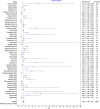Advancing Mammographic Screening Among Underserved Groups: A Systematic Review and Meta-Analysis of Intervention Strategies to Increase Breast Cancer Screening Uptake
- PMID: 40256640
- PMCID: PMC12006734
- DOI: 10.3389/phrs.2025.1607873
Advancing Mammographic Screening Among Underserved Groups: A Systematic Review and Meta-Analysis of Intervention Strategies to Increase Breast Cancer Screening Uptake
Abstract
Objectives: Breast cancer (BC) is a leading cause of cancer related disability and mortality. Despite efforts to implement mammography screening programs, uptake rates vary widely due to socioeconomic factors and accessibility challenges. To improve participation, interventions targeting barriers faced by underserved groups are crucial for promoting equitable screening and early detection.
Methods: A systematic search and meta-analysis was performed to identify strategies to reduce disparities and enhance participation in BC screening, with particular attention to underserved groups, including individuals with low SES, underinsured, with immigrant background or part of ethnic minority.
Results: The meta-analysis of 44 randomized studies involving 161,141 individuals (of which 14,720 belonged to underserved groups) showed that, compared to usual care, interventions regarding BC screening were effective in increasing mammography uptake [pooled OR 1.55 (95%CI 1.39-1.73)], particularly, among underserved groups [pooled OR 1.81 (95%CI 1.43-2.28)]. Overall, the most effective were educational interventions. Among underserved groups, reminders, telephonic interventions, navigation services and cultural-sensitive approaches were highly effective.
Conclusion: Combining these strategies can simultaneously address multiple barriers, ensuring comprehensive support throughout the BC screening process and improved access to screening for underserved groups.
Systematic review registration: Identifier CRD42023393352.
Keywords: breast cancer; breast cancer screening; intervention; mammography; screening uptake.
Copyright © 2025 Ferrari, Jael Herrera, Van De Veerdonk, D’haenens, Ruiz Alejos, Yimer, Orwa, Van Bos, Talboom, Ding, Goossens and Van Hal.
Conflict of interest statement
The authors declare that they do not have any conflicts of interest.
Figures





Similar articles
-
Mobile Mammography Participation Among Medically Underserved Women: A Systematic Review.Prev Chronic Dis. 2018 Nov 15;15:E140. doi: 10.5888/pcd15.180291. Prev Chronic Dis. 2018. PMID: 30447104 Free PMC article.
-
Effectiveness of breast cancer screening interventions in improving screening rates and preventive activities in Muslim refugee and immigrant women: A systematic review and meta-analysis.J Nurs Scholarsh. 2023 Jan;55(1):329-344. doi: 10.1111/jnu.12818. Epub 2022 Oct 5. J Nurs Scholarsh. 2023. PMID: 36199240
-
Association of Population Screening for Breast Cancer Risk With Use of Mammography Among Women in Medically Underserved Racial and Ethnic Minority Groups.JAMA Netw Open. 2021 Sep 1;4(9):e2123751. doi: 10.1001/jamanetworkopen.2021.23751. JAMA Netw Open. 2021. PMID: 34505886 Free PMC article.
-
Engaging diverse underserved communities to bridge the mammography divide.BMC Public Health. 2011 Jan 21;11:47. doi: 10.1186/1471-2458-11-47. BMC Public Health. 2011. PMID: 21255424 Free PMC article. Clinical Trial.
-
Breast Cancer Disparity and Outcomes in Underserved Women.Radiographics. 2024 Jan;44(1):e230090. doi: 10.1148/rg.230090. Radiographics. 2024. PMID: 38127658
References
-
- Kocarnik JM, Compton K, Dean FE, Fu W, Gaw BL, Harvey JD, et al. Cancer Incidence, Mortality, Years of Life Lost, Years Lived with Disability, and Disability-Adjusted Life Years for 29 Cancer Groups from 2010 to 2019: A Systematic Analysis for the Global Burden of Disease Study 2019. JAMA Oncol (2022) 8(3):420–44. 10.1001/jamaoncol.2021.6987 - DOI - PMC - PubMed
Publication types
LinkOut - more resources
Full Text Sources

